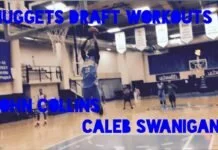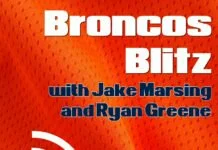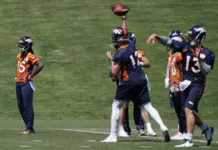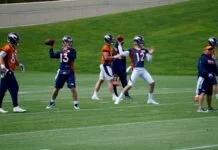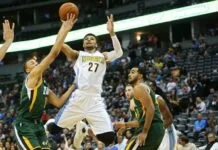Since Peyton Manning’s retirement, the Broncos have been on the hunt for their next signal caller and it seems all options are on the table for General Manager John Elway. It is vital fans look at and try and understand the probabilities of these options working out. Luckily, the tools at ProFootballReference.com make this very easy to do with players drafted at different spots in the draft.
Examining how groups of other players drafted at a similar position did in the NFL is a good way to determine a base rate of success. While there are no doubt additional factors to consider when evaluating a player’s chances of success, framing the question this way gives us a very good starting point. After looking at historical precedent and determining a base rate of success, one can adjust the odds based on other factors.
Paxton Lynch was drafted at the end of the first round, 26th overall. Therefore, the 29 quarterbacks drafted from 2001-2012 in the first or second round, but outside the top ten make for a quality sample to examine. This range is large enough to provide an adequate sample, and it excludes players drafted very early, who have much higher rates of success.
Below, this selection of players are divided into one of four tiers, elite, pretty good, almost good, and failures. While these are arbitrary, they should provide enough resolution for a high level analysis. The percentage of past players who end up in each tier, should provide a good starting point for estimating the odds current or future players achieve levels of success associated with each tier.
At the end of the article there is a table that shows how rates of success change based on draft position.
THE ELITE QUARTERBACKS
3 out of 29 picks, or about a 10% chance.

This is the group everyone hopes Paxton Lynch develops into. An unapologetically elite quarterback, who leads his team to super bowl victories, is a constant pro-bowler, and whose name comes up in MVP talks from time to time. Playing at this level would please even Broncos fans’ high expectations.
THE PRETTY GOOD QUARTERBACKS
3 out of 29 picks, or about a 10% chance.
These are the guys who landed starting roles for extended periods, but were still always answering questions about whether they were “good enough.” They often have some playoff success, but fans will question whether the quarterback deserved the credit or not.
In the current landscape, quarterbacks in this range will command huge $20 million salaries. This prevents a catch 22, because the quarterback may then struggle to maintain success or reach the next threshold with increased pressure, and after eating up so much cap space
THE ALMOST GOOD QUARTERBACKS
3 out of 29 picks, or about a 10% chance.
These guys played at a high level for a short period, or held down starting roles for extended periods, but never took the next step. Josh Freeman could have been placed in the tier below, but was given the benefit of the doubt.
FAILED QUARTERBACKS
20 out of 29 picks, or about a 70% chance.
This section could be further broken out, but that would be splitting hairs. There are players on this list who were given long leashes, but never improved (Kyle Boller), players who were so bad they almost never saw the field (Pat White), players who seemed like they were poised to break out, but never were in the right place at the right time (Tavares Jackson), and many more stories.
What they all have in common is that fans probably do not consider these draft picks a success, especially if they were drafted onto teams that eventually had an opening at quarterback that the player failed to seize.
Hopefully, if teams do draft a guy in this category, they get some quality backup play or can squeeze one or two productive seasons out of the guy. But soon enough, there will come a time early on where he will disappoint, fans will question the pick, and teams will be forced to move on.
To make sure the last 15 years weren’t an abnormality, all the quarterbacks drafted in the same range from 1985-2000 were also examined. The results were maybe slightly better on the back end, likely due to less pressure at the position 20 years ago, but overall pretty much the same. There were 24 quarterbacks drafted in this time frame. One or two (Brett Favre and possibly Randall Cunningham) could be classified as elite. Three more (Daunte Culpepper, Jim Harbaugh, and Jake Plummer), would likely fall in the pretty good category.
Four or five would fall into the almost good category (Kordell Stewart, Chad Pennington, Chris Miller, possibly Tony Banks and Charlie Batch). These could be up for debate, but regardless over 60 percent (14 of 24) were still in the “failure” category.
To repeat, 60-70% of players drafted between the mid-first round and the second-round fall into the “failure category.”
This isn’t some baseless coincidence, or curse of the late first round draft pick, or anything like that. If this analysis was done with third, or fourth, or fifth round picks, the results would trend how expected, with the probability of failure going up as quarterbacks from a later round are examined.
For those looking for a more quantitative assessment, there is a table at the end of the article that shows different metrics for quarterbacks by draft position. These break down the trends further, but the result is the same.
WHAT THIS MEANS FOR THE BRONCOS
While this may seem like a very pessimistic statistic, the good news for the Broncos is that their stout defense may increase the likelihood a young quarterback is successful, especially in the short term. Looking through the list of successful starting quarterbacks who were drafted later, many were paired with a great defense. Guys like Russel Wilson, Joe Flacco, Ben Roethlisberger, Andy Dalton and so many more had strong defenses who helped take the pressure off. As the Broncos have done, it may make more sense to try and build a support system around a quarterback, rather than invest further draft capital or cap space towards the quarterback position.
Additionally, this stat doesn’t necessarily dictate the Broncos should necessarily sign Tony Romo, unless they are confident he’ll be a fit. As free-agent quarterbacks similar to Romo are incredibly rare, it’s not practical to use historical precedent to generate a probability of success for his potential signing. But the chances he can stay healthy behind our offensive line, adjust quickly to a new scheme and receivers, and regain his high level of play after two injury riddled seasons do seem low. However, it’s certainly hard not to be intrigued by the thought of bringing in a proven option after knowing the long odds for Lynch.
If the Broncos do sign Romo or another high-profile veteran, they should keep their options open. Many fans have argued in this scenario the Broncos should trade Siemian for a mid-round draft pick. This would be a huge mistake. With the tough odds all quarterbacks face, keeping as many options on the table as is practical is the best bet. Further, if Elway doesn’t sign Romo, he should look for a third and fourth quarterback that may still have some potential, rather than someone like Austin Davis who was a complete afterthought. Granted, the odds of these signings being a hit will be incredibly low, but why not make the most out of the roster spot.
Most importantly, fans should have realistic expectations. If Lynch is a complete bust, it does not mean Elway is a failure. He’s just a victim of long odds in a high stakes, high rewards game.
TABLE OF QUARTERBACK SUCCESS BY DRAFT POSITION
Table 1 Various rates of success for QBs drafted between 1990 and 2013. Rates of success decrease drastically for quarterbacks drafted later in the draft





